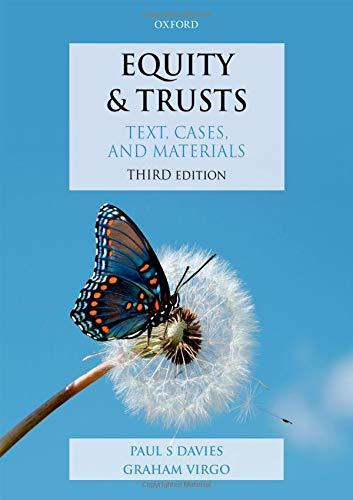Question
After making a very wise investment in art several years ago, STEVE SELLER has decided it is time to sell the famous painting, entitled Bowl
After making a very wise investment in art several years ago, STEVE SELLER has decided it is time to sell the famous painting, entitled "Bowl of Fruit" by artist Donna Blanton. The painting an approximate fair market value of $30,000 and is an oil on canvas original.
STEVE places and ad on Craigslist which is answered by BOB BUYER. After inspecting the painting, BOB says he'll return at 6:00pm on October 31, 20XX with $27,500 "in cash."
Assume you are STEVE SELLER, draft a simple contract that you and BOB BUYER can execute. Use October 31, 20XX
Use your creativity, imagination, legal experience, business experience, common sense, and negotiating skills to draft a contract that binds the other party, best serves and protects you, but also is fair enough that the other party will likely agree to its terms, or at least most of them. Turn in your best non-lawyer attempt at drafting a written contract in proper word-processed format. Make sure to cover all the basic contract requirements andadd whatever other provisions make sense to best serve your interests.Make reasonable assumptions for any additional information that you need that is not furnished.Neither buyer nor seller is a merchant - they are private parties.
The contract is to be very simple, yet enforceable by any court in California.
The Agreement should contain all necessary and at least 2 appropriate standard "boiler plate" contractual provisions. You may make up and add such additional facts and terms that you deem appropriate.
Reminders:
The basic elements of a purchase/sale agreement are:
- Identification of the parties
- Dates of acceptance and delivery
- Quantities and specifications of goods
- Place and terms of delivery
- Warranties and disclaimers
- Payment terms
BUS140: Legal Environment of Business
Contract Evaluation Criteria
An "A" Contract:
- Contains all required elements: agreement, consideration, capacity, legality, and consent.
- Includes all required clauses and terms from the assignment directions.
- Writing is Superior: clear, organized, with proper grammar and sentence structure.
- All Terms present and favorable to drafter.
- If using template, all extraneous language (including repetitive clauses) have been removed.
- At least 3 relevant boilerplates are included in the agreement.
A "B" Contract:
- Contains required elements but one or more may need to be interpreted from the spirit of the contract.
- Includes required clauses but one is missing or obscured.
- Demonstrates competence in writing, may have some errors, but not enough to distract or confuse the reader.
- All terms are present but one or more may not be favorable to drafter.
- Template has been reviewed and extraneous language removed but one or more statements exist that confuse reader or contradict assignment directions.
A "C" Contract:
- One or more contract elements is missing.
- Includes some clauses, however other required clauses/terms are missing.
- Writing is adequate. Contains some errors that distract the reader, but they do not obscure the meaning.
- Terms are missing; those present may not be favorable to drafter.
- Template contains minimal editing thereby confusing the reader with descriptions and terms that are inconsistent with the nature of the deal.
A "D" Contract:
- Contains some required elements but one or more is missing.
- Does not include required clauses/terms.
- Does not follow assignment directions.
- Writing demonstrates developing confidence, but is flawed in some way.
- Multiple terms are missing; those present are not favorable.
An "F" contract
- Contract is unfocused, poorly organized, and underdeveloped and may be characterized by frequent and serious errors.
Is Your Contract Solid?
Many students elect to use a contract template to complete the "Drafting A Contract" assignment. Using any widely available template is fine, however, you must remember to completely EDIT the template to ensure you contract is clear and unambiguous. Below are some of the issues frequently associated with templates.
1. Identification of parties. Is it clear who is contracting? Do you know where to locate them? Is extraneous language removed?
2. Goods: are they congruent with the requirements of the assignment?
3. Delivery: quantity requested. Are you buying or selling more than one? Does this section need to be edited?
4. Term: do you need more than one day to complete the transaction?
5. Acceptance: buyer wants time, seller wants to get the deal done.
6. Charges: "seller shall invoice buyer for each shipment..." Are you expecting more than one?
7. Warranty: who wants it? Should it be at seller's discretion?
8. Should the seller attest to the painting's "perfection?"
9. Payment - what is acceptable?
10.Are there wishy-washy terms like "about" "approximately" included in the contract?
11.Method of payment - does it matter?
12.Contradictions - the contract should have no contradicting terms.
13.Is extraneous language removed?
14.Does the contact MAKE SENSE to you?
Step by Step Solution
There are 3 Steps involved in it
Step: 1

Get Instant Access to Expert-Tailored Solutions
See step-by-step solutions with expert insights and AI powered tools for academic success
Step: 2

Step: 3

Ace Your Homework with AI
Get the answers you need in no time with our AI-driven, step-by-step assistance
Get Started


